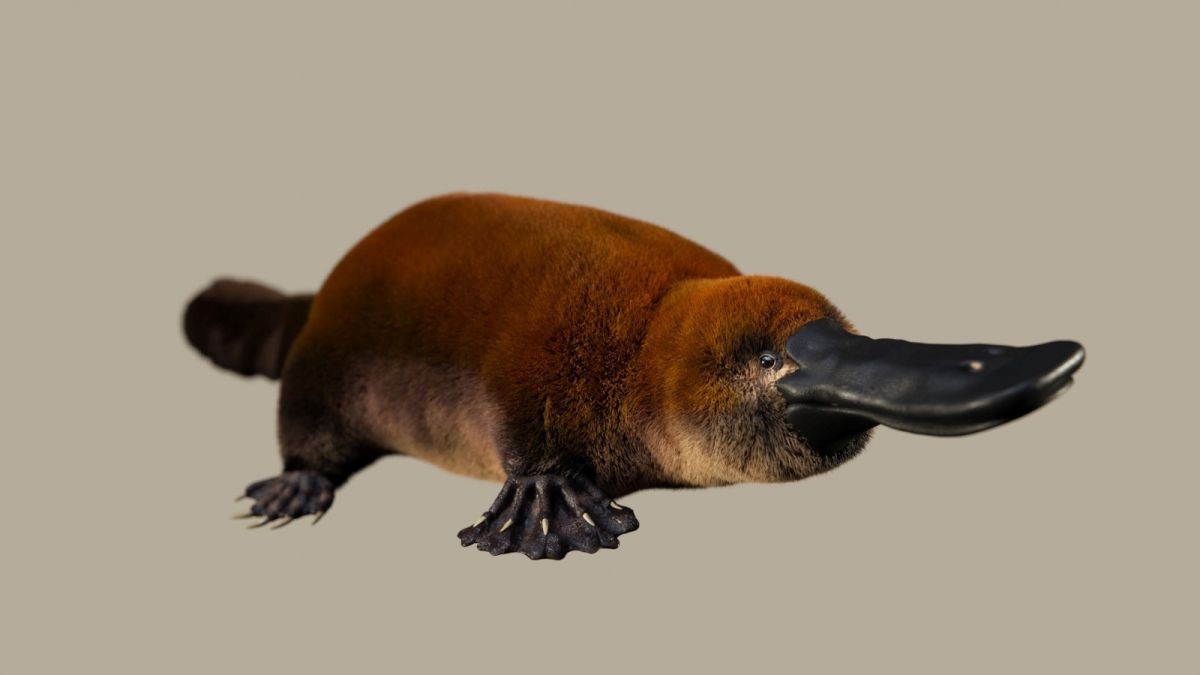An artist’s illustration of what Patagorhynchus pascuali probably looked like in life. (Image credit: Courtesy of Fernando Novas)
Around 70 million years ago, a small, furry, platypus-like creature shuffled along the banks of an ancient lake. This would not have been a remarkable occurrence, except for one thing: The lake was in present-day Argentina, not Australia.
The creature, dubbed Patagorhynchus pascuali, is the oldest fossil of the egg-laying mammal group known as monotremes ever discovered in South America. The discovery may rewrite the story of where these oddball early mammals evolved. Today, all five species of living monotremes — which include the platypus (Ornithorhynchus anatinus), the short-beaked echidna (Tachyglossus aculeatus) and three species of long-beaked echidnas (Zaglossus) — are found exclusively in Australia and a few of its surrounding islands. So how did a platypus ancestor wind up so far from Down Under?
Millions of years ago, Australia, South America and Antarctica (as well as parts of Africa and Asia) were smooshed together in a supercontinent called Gondwana. This mega landmass began to break up about 180 million years ago, during the Jurassic period, but didn’t fully separate until about 66 million years ago, at the end of the Cretaceous period.
A reconstruction of Patagorhynchus pascuali‘s skull, with the fossilized molar. (Image credit: Courtesy of Fernando Novas)
Because more recent monotreme fossils have been found in South America, scientists previously speculated that the group evolved on the Australian landmass after this continental breakup and later migrated back to South America across a land bridge. But the fact that P. pascuali existed in Argentina before the continental breakup tells a different story.
“Our discovery clearly demonstrates that Monotremes didn’t evolve uniquely in the Australian continent, but also in other parts of southern Gondwana,” study co-author Fernando Novas (opens in new tab), a paleontologist at the Bernardino Rivadavia Natural Science Museum in Buenos Aires, Argentina, told Live Science in an email.
Related: Prickly echidnas stay cool by blowing snot bubbles
A close-up of the fossilized molar from the ancient platypus relative Patagorhynchus pascuali. (Image credit: Courtesy of Fernando Novas)
The specimen, which was described in the journal Communications Biology (opens in new tab) on Feb. 16, was identified by a fragment of a lower jaw containing a molar. When it comes to studying fossilized mammal remains, “teeth give us a huge amount of information,” Robin Beck (opens in new tab), an evolutionary biologist at the University of Salford in the U.K. who was not involved in the study, told Live Science in an email. In the case of monotremes, though, dental identification is a bit more complicated.
“Living platypuses lack teeth,” Novas said. But another extinct platypus relative, the 30 million-year-old Obdurodon, retained teeth in both its upper and lower jaws. The P. pascuali molar closely resembled these teeth, as well as the very small, imperfect teeth that baby platypuses briefly possess.
Based on its teeth and apparent habitat, P. pascuali likely had a diet similar to that of a modern platypus: mainly, small aquatic invertebrates, including insect larvae and snails. The Argentinian fossil bed where it was discovered bears this out; Novas said that they found insects and snail shells in the sediments around P. pascuali. Additionally, the researchers uncovered the fossilized remains of other early mammals, turtles, frogs, snakes, aquatic plants and a variety of dinosaurs.
While the discovery constitutes an important and interesting new piece of the monotreme evolutionary puzzle, researchers are still far from a complete picture. “There are still huge gaps in the monotreme fossil record,” Beck said. For instance, although no monotreme fossils have been discovered in Antarctica, given its previous proximity to Australia and South America, there are likely ancient platypus bones deep beneath the ice.
But as a South American paleontologist, Novas said, it’s pretty cool to know that “the great grand-father of the Australian Ornithorhynchus was Argentinian.”
































